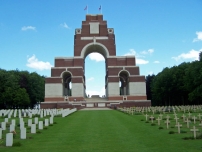| First Name: | Joseph Frederick | Last Name: | EMONS | |
|---|---|---|---|---|
| Date of Death: | 15/09/1916 | Lived/Born In: | Millwall | |
| Rank: | Corporal | Unit: | Dragoon Guards7 | |
| Memorial Site: | Thiepval Memorial, France | |||
Current Information:Born-Old Ford
The Battle of the Somme (July-November, 1916) By the beginning of September, 1916, the Battle of the Somme had been raging for two months. Thousands of men had already been killed or wounded or were simply missing, never to be seen again and and just a few square miles of the French countryside, all in the southern part of the battlefield, had been captured from the enemy. Mistakes had been made by the various commanders and would be continued to be made but there was no turning back as the British, Australians, South Africans, New Zealanders and Canadians carried on battering away at the German defences in the hope of a breakthrough, So it continued all the way through to November with nearly every battalion and division then in France being drawn into it at some stage. In the end the German trenches had been pushed back a few more miles along most of the line but the cost in lives had been staggering. By the end of the fighting in November, 1916, British Army casualties numbered over 400,000, killed, wounded and missing. The Battle of Flers-Courcelette (15-22 September, 1916) On 15th September, 1916, the offensive on the Somme was renewed with a full scale attack on the German third line of defences. Four Army Corps were used on a front that stretched from Combles, through the village of Flers and on to Courcelette.. The artillery barrage that preceded this attack was more concentrated than that on 1st July and the attack itself was more successful. The villages of Flers, Martinpuich and Courcelette were captured and the enemy was finally pushed out of High Wood, but the breakthrough was not achieved and the reality was that when the battle ended on 22nd September, the front line had just been moved forward a mile or so. The battle is notable for being the first time that tanks were used. It was hoped that the use of the tanks would destroy the German defences enough to allow the cavalry to pass through and penetrate deep into enemy territory but the tanks had a limited impact on the battle and this did not happen. Instead the cavalry units remained where they were or moved forward to positions of readiness until they were finally stood down. On 15th September, 1916, 7th Dragoon Guards of 9th (Secunderabad) Brigade, 1st Indian Cavalry Division left bivouacs south of Dernancourt and moved to a position west of Mametz where their bivouacs were shelled overnight. Four horses were killed and it is likely that Joseph Emons was also a victim of this shelling. |
||||
| « Back to Search Results | ||||
| If you think any of the information shown here is incorrect, Click Here to submit your amends and comments | ||||




